
From the Death Valley turtleback detachment.

Death Valley is an active rift linked to strike-slip faults. Exposed in the footwall of the modern rift is a somewhat older, extensive fault surface that is folded in shapes so that they are called turtlebacks. This image is a small part of that slip surface. The brown rocks are sandstones and conglomerates that are part of the rift fill, while the underlying greenish rocks are basement rocks that have been mylonitized, brecciated, chloritized and otherwise mutilated by the fault movement. You can see orange staining along the fault surface, which likely reflects groundwater processes. Note how the sandstone comes in at an angle, but then follows the fault surface for some distance before pinching out. There is debate on how much movement has occurred on this fault surface, but kilometers is minimal, and tens of kilometers has been proposed.

These are quartz-feldspathic rocks in the immediate footwall of the Death Valley turtleback detachment. These were migmatitic basement rocks before fault shearing. Distributed discrete slip surfaces, such as the one that the pencil points to can be seen to permeate this rock, all with hanging wall down displacement (consistent with the detachment being a low angle normal fault). Finely distributed slip is also concentrated in the darker more mica rich rocks. Mica is a very important mineral in controlling rock deformational behavior. A close looks also shows feldspars in the compositional layering to have an augen shape, consistent with more ductile deformation. This is interpreted as an earlier phase of ductile fault movement overprinted by the later more brittle phase.
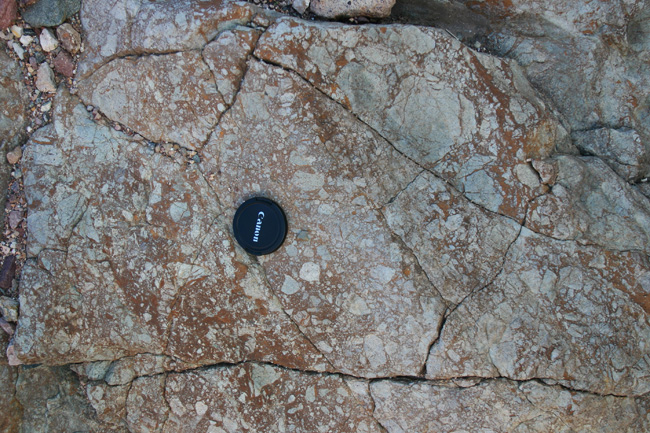
This image is from within the cataclastic fault core of the detachment and shows brecciation of some hypabyssal (very shallow) intrusions that came in along the fault. Clasts can be seen frozen in the process of fracturing and breaking up. The fact that igneous material was locally intruding along the fault as it was moving, opens up possibilities of igneous melt lubrication. However, little evidence was seen for this, and it may be that the time frames were not permissive, with the melt 'freezing' up before it could do much lubrication.

This is weakly foliated fine-grained cataclastite material right beneath the turtleback detachment, which some would call fault gauge, right under the fault boundary with the overlying fanglomerate sediment. Note how the larger clasts in the gauge are rounded. This is not uncommon in some well developed gouge zones. During the milling and brecciation process larger clast corners can get rounded, but once they are floating in weaker and finer-grained fault material they are protected from further crushing and fracturing, which becomes concentrated in the weaker matrix.
This is from the fault core of the detachment. The whitish and lighter green rock can be seen to be laced with a fine network of fractures filled with dark aphanitic material. These could be frictional fault melts, pseudotachylites, that formed from sudden slip and injected the fractures produced by slip. There is nearby hypabyssal intrusive material that could also be the source of the aphanitic material, but the very fine distribution is more consistent with local formation along the slip planes. Some geochemistry could likely tell which of these two hypotheses is correct.

The sandy bed forming a ledge is offset by two small normal faults (hanging wall down to the left). Aggregate throw is about two meters. There is some tilting of the bedding in the block between the two faults. This is likely due to the fault surface to the right being curved. It is quite likely that the two faults join into one at depth.

View of exposed fault surface. Note mechanical pencil for scale. The gray material is chalcedony vein rock that commonly occurs along the fault planes in the Chadron Formation. Since the chalcedony is more resistant to erosion than the surrounding rock the fault surfaces are well exposed. Note the dip-slip striae on the 60° dipping fault surface. The faults at Toadstool are normal faults.


In this close-up of a fault surface, a vug filled with calcite crystals is common. The striae, and hence slip, appears to be concentrated along the fault zone margin, while the vugs and chalcedony vein material indicates significant dilation (opening). Dilation is especially common in normal fault zones. Since both are characteristic of the exposed length of the fault, these brittle features may actually be mixed mode, with both both tensile and shear components.
Synsedimentary Triassic fault features from Edgeoya, Svalbard

Note in this cliff side that is over 1000 feet high (small orange dot on shore is a person in a survival suit) of Triassic strata how the upper strata are not offset, while the lower strata are both faulted and rotated. Notice also how the light-colored sandstone units thicken against the fault. All of this is consistent with these being growth faults, where faulting provides space that is filled with sediment as faulting is occurring. While some minor erosion of fault block shoulders is evident in other parts of this cliff side, overall there is not evidence for significant erosion, and so all the fault features formed at a shallow depth, clearly in the upper several hundred meters of the earth's surface. The pictures below show some details.
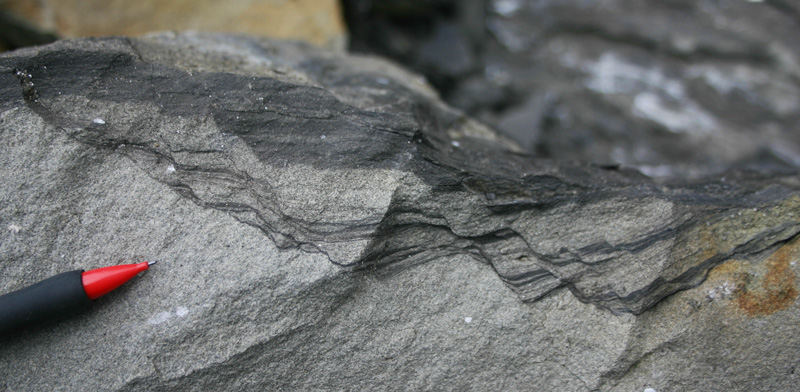
Displayed here is a collection of small scale soft-sediment faults. Soft-sediment faults form when the material is still sediment, and the grains are not cemented together. The deformation mechanism is granular flow (grain rearrangement) and not truly brittle movement on a discrete surface. In this way the deformation is akin to deformation bands. Note also how some of the small faults in the interbedded shale-sandstone unit do not offset the boundary with the more massive sandstone below. Instead they bend into parallelism with the contact. This causes rotation of the bedding above this level, and so here we see in very small scale, a pattern that exists on the much larger scale. Not also how the mud (now shale) behaves differently than the sand, with a more ductile style and is sheared out along the fault plane. This phenomena of a clay smear can seal the fault to fluid flow. Finally, note how the faults are difficult to trace in the underlying sandstone, probably because of the lack of marker horizons, or potentially because the slip was distributed into a much more diffuse area.
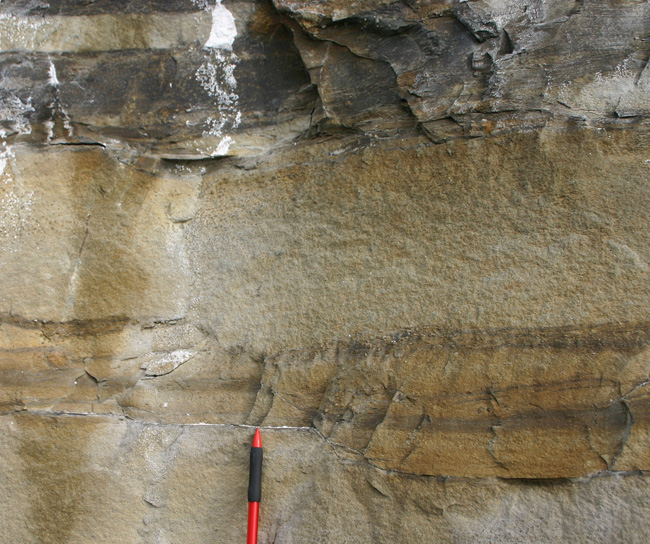
Another soft-sediment fault nearby the one depicted above. These small features occur in very close proximity to the very large fault shown in the first image from Edgeoya, and the interpretation is that they occur at the same time, which is consistent with the very shallow level and synsedimentary nature of the faulting. Note here how the uppermost layers are not cut by the faulting. By this time this small fault strand has stopped moving. Also note how the fault is not planar, but approximately curve. Finally, note again how the fault is not visible in the more massive sandstone. Marker horizons are needed to work out fault geometry.
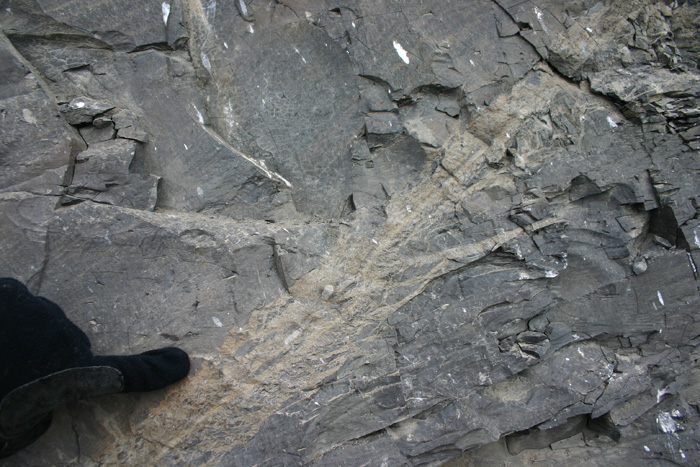
The lighter colored material is fibrous vein fill that occupies this fault in some shales. That a fault exists where the veins are located is evident by how the more shallowly dipping bedding and fissility in the footwall truncates against the fault (footwall cutoff). The bedding and shale fissility in the hanging wall is parallel to the fault (hanging wall flat). The veins have a distinctly brittle character, in contrast to the soft-sediment deformation seen above. Our interpretation is that lithification and deformation were occurring at the same time, and that early and shallower stages of deformation had a soft-sediment character, while later and deeper deformation has a brittle style. The presence of veins parallel to the fault also suggests that high fluid pressures were involved, which we will see later in the course are often a very crucial factor in facilitating faulting.
Faults in the Niobrara Chalks of Kansas (and elsewhere)
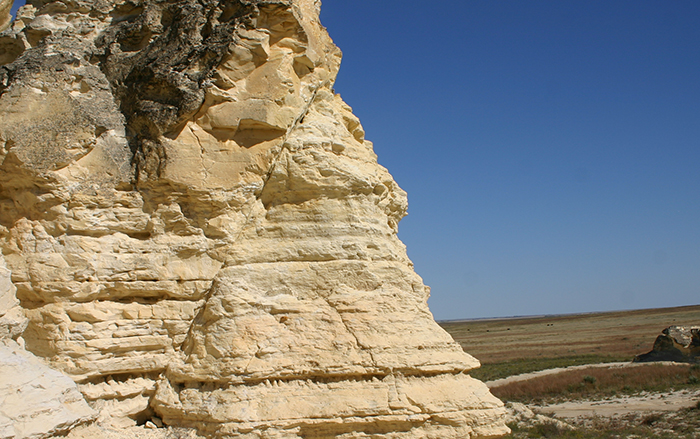
This is a view of a planar normal fault in Niobrara Chalks (Cretaceous) exposed at Castle Rock, west central Kansas. A thin bit of fault rock can be seen in the upper portion, but otherwise the fault does not appear to have a damage zone, and appears as distinct, singular slip surface. Such faults are found widely distributed in Niobrara Chalks are proposed to be burial and compaction related and not tectonic in origin.

This is a close up of the fault surface of one of these faults, which is dipping toward the viewer. The fault surface is ornamented with linear features in a down-dip position, and these are interpreted to provide the direction of movement in the fault plane. A close up is provided below.

In this close-up of the above fault surface these linear features can be seen to be micro-corrugations, small wrinkles in the fault surface. The corrugated slip surface bounds calcite vein material immediately beneath that comprises the fault zone. These are similar to calcite slickensides seen on fault surfaces, but one subtle difference is that here the calcite is not a fibrous mineral growth in the direction of fault movement, but coarse sparry, calcite. There is evidence that this sparite has replaced an earlier mineral. Corrugations occur on faults at multiple scales, and the reasons for these corrugations are not particularly well known. Also note the small steps in the slip surface. In this particular rock these form where breakage occurred along a small fault-oblique micro-vein that linked two of corrugated slip surfaces, a geometry that characterizes the faults in the Niobrara.

Here the surrounding softer chalk has largely weathered away, and the fault zone, composed of sparry calcite, is ore resistant and sticks out as a small fin on top of this small knoll. The micro-corrugations can be seen, and a close look shows some of these to occur in distinct irregularly lenticular pods elongate to the corrugations. There is also some sulfide mineralization that occurred (the rusty colored material).
Harmon Maher, Sept. 2014